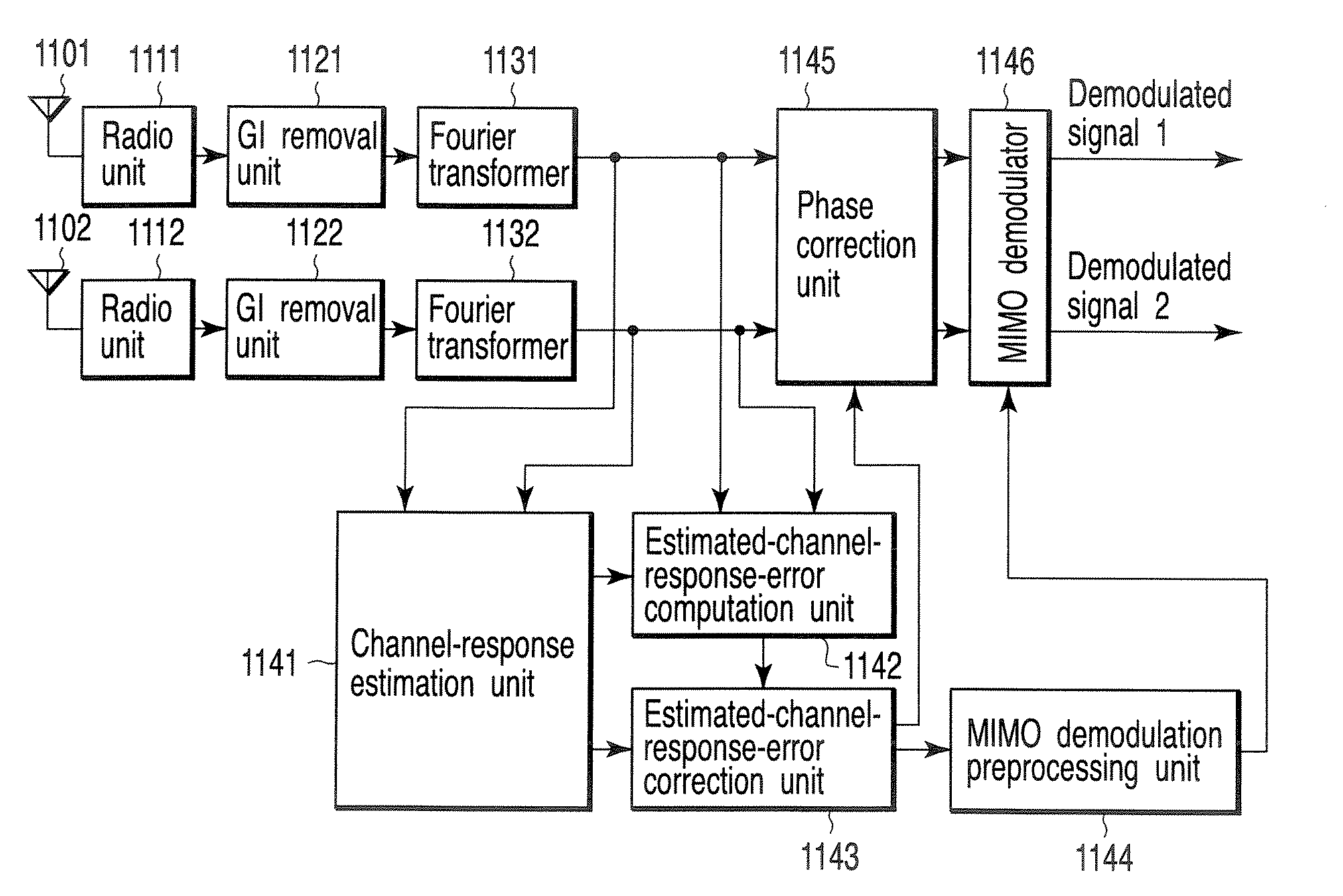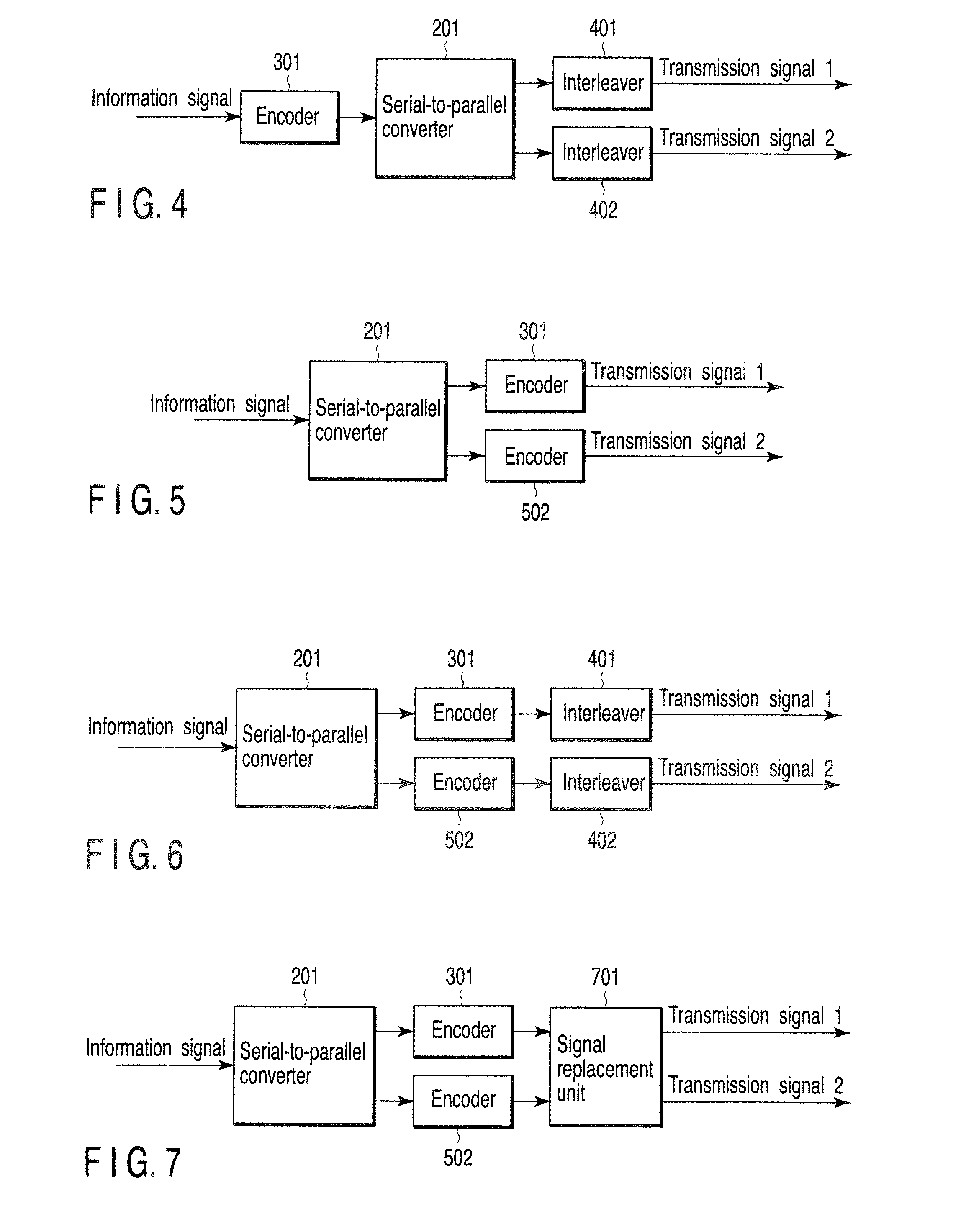Wireless receiving apparatus and method
a receiving apparatus and wireless technology, applied in the field of wireless receiving apparatus and method, can solve the problems of inability to generate accurate sine waves and conventional wireless receiving apparatuses cannot correct errors
- Summary
- Abstract
- Description
- Claims
- Application Information
AI Technical Summary
Problems solved by technology
Method used
Image
Examples
first embodiment
[0064]Referring first to FIG. 11, the configuration of the wireless receiving apparatus of a first embodiment will be described. FIG. 11 shows a configuration example of the wireless receiving apparatus according to the first embodiment, in which the number of streams to be multiplexed is 2, and the number of receiving antennas is also 2.
[0065]The wireless receiving apparatus of the first embodiment comprises receiving antennas 1101 and 1102, radio units 1111 and 1112, GI removal units 1121 and 1122, Fourier transformers 1131 and 1132, channel-response estimation unit 1141, estimated-channel-response-error computation unit 1142, estimated-channel-response-error correction unit 1143, phase correction unit 1145, MIMO demodulation preprocessing unit 1144 and MIMO demodulator 1146.
[0066]The radio units 1111 and 1112 perform radio processing through the receiving antennas 1101 and 1102, respectively, thereby converting radio frequency signals into digital signals. The receiving antennas ...
second embodiment
[0168]A wireless receiving apparatus according to a second embodiment has the same configuration as that of the first embodiment shown in FIGS. 11 or 13, and is similar to the latter in that an estimated channel-response error, caused by the frequency offset between the transmission apparatus and wireless receiving apparatus and phase noise resulting therefrom, is corrected using pilot subcarriers.
[0169]The second embodiment differs from the first embodiment in the scheme of computing a weight in units of pilot subcarriers to acquire an estimated channel-response error. Specifically, they employ different weight computation methods for the estimated-channel-response-error computation unit 1142. In the first embodiment, a weight is computed in units of pilot subcarriers using the equations (42) to (45). This method involves no problems if the signal-to-noise ratio (SNR) is high, and signal power is sufficiently higher than noise power. However, if SNR is low, noise may be emphasized ...
third embodiment
[0193]A wireless receiving apparatus according to a third embodiment has the same configuration as that of the first or second embodiment shown in FIGS. 11 or 13, and is similar to the first or second embodiment in that an estimated channel-response error, caused by the frequency offset between the transmission apparatus and wireless receiving apparatus and phase noise resulting therefrom, is corrected using pilot subcarriers.
[0194]The third embodiment differs from the first or second embodiment in the scheme of computing a weight in units of pilot subcarriers to acquire an estimated channel-response error. Specifically, they employ different weight computation methods for the estimated-channel-response-error computation unit 1142.
[0195]In the first and second embodiments, a weight is computed in units of pilot subcarriers using the equations (42) to (45) and the equations (80) to (83), respectively. These methods utilize common inverse matrix G−1 for all subcarriers, and hence redu...
PUM
 Login to View More
Login to View More Abstract
Description
Claims
Application Information
 Login to View More
Login to View More - R&D
- Intellectual Property
- Life Sciences
- Materials
- Tech Scout
- Unparalleled Data Quality
- Higher Quality Content
- 60% Fewer Hallucinations
Browse by: Latest US Patents, China's latest patents, Technical Efficacy Thesaurus, Application Domain, Technology Topic, Popular Technical Reports.
© 2025 PatSnap. All rights reserved.Legal|Privacy policy|Modern Slavery Act Transparency Statement|Sitemap|About US| Contact US: help@patsnap.com



